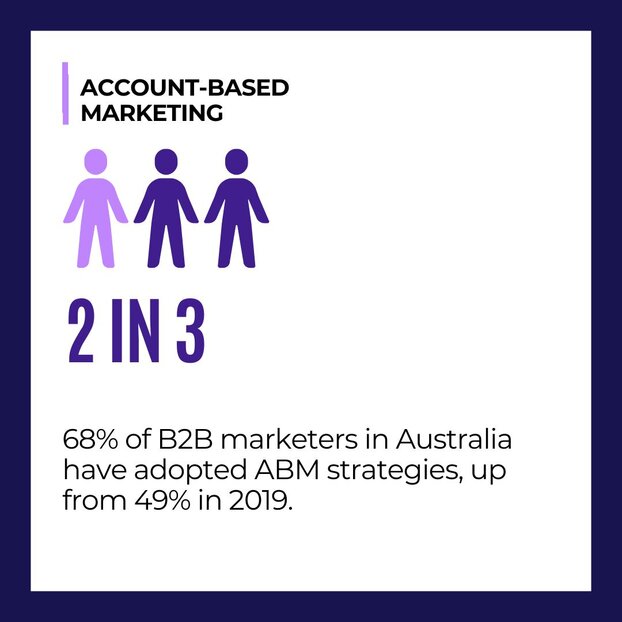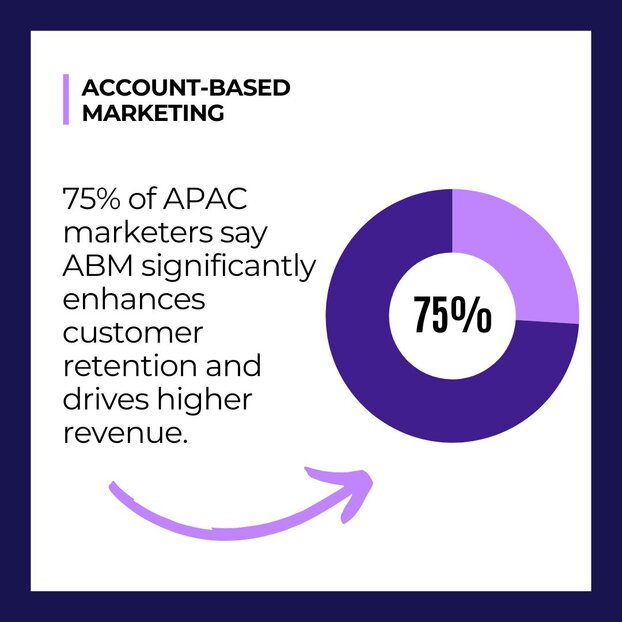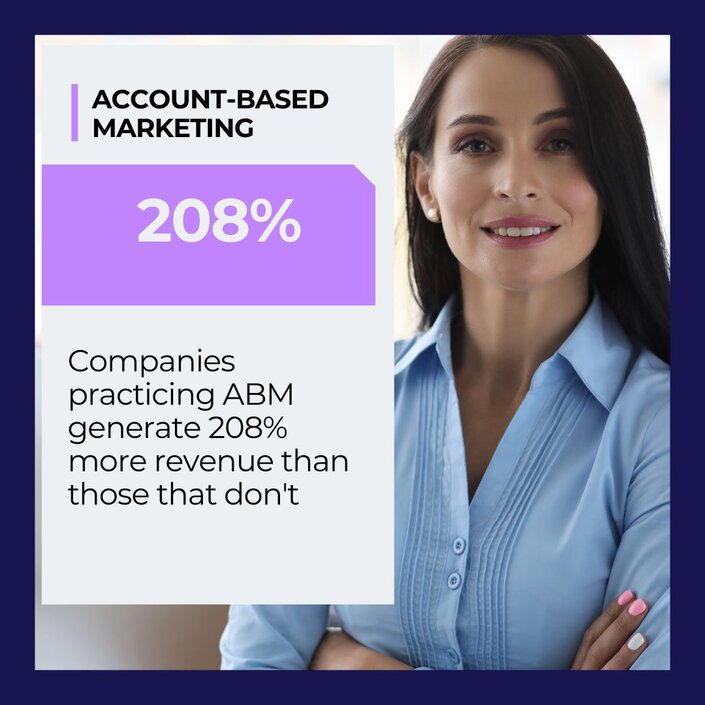What is ABM Marketing?
Imagine you’re planning a surprise birthday party. But this isn’t just any party—it’s for someone incredibly special. You don’t just throw up some generic balloons and hope they like cake. No, you call their closest friends, figure out their favorite dessert (it’s not cake, it’s tiramisu), and book that rooftop venue they’ve been raving about. Every detail is designed specifically for them, making it an unforgettable experience.
That, in essence, is Account-Based Marketing (ABM)—a highly targeted, bespoke approach to marketing that prioritises quality over quantity.
ABM marketing isn’t about chasing after every potential lead. It’s about zeroing in on your most valuable prospects—the ones who could transform your business—and treating them like VIPs. Instead of casting a wide net and hoping for a catch, ABM is like spearfishing: precise, deliberate, and tailored.
From a Spray-and-Pray Past to Laser-Focused Precision
To truly understand what ABM marketing is, it helps to reflect on what it isn’t. Traditional marketing is often a numbers game. You build broad campaigns, aim for mass appeal, and hope some percentage of your audience converts. It’s the digital equivalent of handing out flyers on a busy street—sure, someone might stop to look, but most will just keep walking.

ABM marketing flips that script. It’s not about getting everyone’s attention; it’s about getting the right attention. With ABM, you carefully select high-value accounts, learn everything you can about them, and create personalised campaigns that speak directly to their needs, challenges, and aspirations.
Think of it as sending a heartfelt handwritten note instead of a generic email blast. ABM marketing shows your prospects that you understand them, respect their time, and have something genuinely valuable to offer.
The Personal Touch That Sets ABM Marketing Apart
Picture this: You’re a B2B SaaS company targeting a Fortune 500 financial institution. In the old-school marketing playbook, you might send them a generic email saying, “Try our product; it’s great for businesses like yours.” But with ABM marketing, you take a completely different approach.
You do your homework. You discover that their CIO recently mentioned in an interview that their biggest challenge is streamlining customer onboarding. Armed with that insight, you create a custom case study showcasing how your platform helped another financial institution cut onboarding times by 30%.
You send this directly to the CIO, accompanied by a tailored video message from your CEO. The result? You’ve created a campaign so relevant and compelling that it’s hard to ignore.
This is the magic of ABM. It’s about making your prospects feel seen, understood, and valued. It’s not just marketing; it’s building relationships that matter.
Why ABM Marketing Works in B2B
Now, let’s address the elephant in the room: Why has ABM marketing become such a buzzword in the world of B2B? The answer lies in the complex nature of B2B buying decisions.
Unlike in B2C, where a single person often makes the purchase, B2B decisions involve multiple stakeholders—sometimes an entire committee. According to research, an average of 6–10 decision-makers are involved in every major B2B purchase. This means your marketing needs to resonate not just with one person, but with an entire group, each with their own priorities and concerns.
ABM marketing thrives in this environment. By targeting specific accounts and tailoring your messaging to the different stakeholders within those accounts, you create a unified narrative that addresses their collective needs. It’s like hosting a dinner party where every guest’s favorite dish is on the menu. Everyone feels considered, and everyone leaves satisfied.
ABM: A Game of Strategy and Storytelling
At its core, Account-Based Marketing (ABM) is as much about storytelling as it is about strategy. It’s not just about targeting accounts with precision; it’s about crafting a narrative that resonates deeply with each prospect. ABM invites you to step into your prospects’ shoes, understand their challenges, and offer solutions in a way that feels personal and authentic.
Think of ABM as the ultimate blend of data and creativity. Data guides you to the right accounts and uncovers what matters most to them. Creativity allows you to transform that insight into a story that connects. It’s the difference between saying, “We have a solution for you” and showing, “We understand you, and here’s how we can help.”
But ABM isn’t just about generating leads—it’s about cultivating advocates. When executed well, ABM doesn’t end with a closed deal. Instead, it sparks partnerships that grow over time. These advocates aren’t just customers; they become champions of your brand, driving referrals, repeat business, and even collaboration on future innovations.
“It’s not about selling to companies; it’s about building relationships with people.”
This perspective underscores the human element at the heart of ABM. Behind every account are decision-makers who want to feel understood, respected, and valued. ABM is your opportunity to speak directly to their aspirations.

Account-Based Marketing Types: 1:1, 1:Few, and 1:Many
ABM is not a monolithic approach but rather a spectrum that includes different levels of personalisation: 1:1, 1:Few, and 1:Many. Each type serves distinct purposes and suits different stages of the sales cycle.
1:1 ABM is the most personalised approach, often referred to as "Strategic ABM." This method involves creating bespoke marketing plans for individual accounts. It's akin to a white-glove service where every touchpoint is tailored to the specific needs and preferences of a single account. This approach is ideal for targeting high-value clients who can significantly impact your revenue. For example, an Australian tech firm might create a custom event for a large banking institution, addressing their unique pain points and aligning solutions with their strategic goals. This deep personalisation fosters strong relationships and can lead to long-term partnerships.
1:Few ABM, or "ABM Lite," targets small clusters of similar accounts. These accounts share common characteristics, such as industry, company size, or specific needs. This approach allows for some level of personalisation without the intensive resource investment of 1:1 ABM. It’s effective for mid-tier accounts that, while not as individually lucrative as those targeted by 1:1 ABM, collectively represent a significant revenue opportunity. For instance, an Australian SaaS company might develop a campaign for a group of healthcare providers, focusing on shared regulatory challenges and operational needs.
1:Many ABM, or "Programmatic ABM," casts a wider net by targeting larger groups of accounts with common attributes. This approach leverages technology to scale personalised messages to a broader audience. It’s suitable for lower-value accounts that, although individually less significant, collectively contribute to substantial revenue. Programmatic ABM employs data-driven insights to create semi-personalized content at scale. For example, an Australian marketing agency might run a digital campaign targeting small and medium-sized enterprises (SMEs) across various industries, focusing on common challenges like digital transformation and market competition.
ABM is a game-changer for B2B marketing. By focusing on high-value accounts and delivering personalized campaigns, ABM allows companies to be more strategic and targeted in their marketing efforts, resulting in higher conversion rates, increased engagement, and improved alignment between sales and marketing teams.
Brian Sharp, Vice President of Marketing, LeanData
Account-Based Marketing Strategy
Developing a robust ABM strategy requires meticulous planning and alignment between marketing and sales teams. Here are the key components that need to be addressed:
Defining Objectives and KPIs
The first step in an ABM strategy is to clearly define your objectives and key performance indicators (KPIs). Objectives could include increasing revenue from key accounts, improving customer retention, or penetrating new market segments. KPIs should be aligned with these objectives and could range from engagement metrics (e.g., email open rates, website visits) to financial metrics (e.g., deal size, revenue growth).
Identifying Target Accounts
Identifying and selecting the right accounts is critical. Use data-driven insights to pinpoint accounts that align with your business goals and have the highest potential for revenue generation. Consider factors such as company size, industry, geographic location, and buying behaviour. In the APAC region, leveraging local market intelligence and cultural nuances can significantly enhance account selection accuracy.
Developing Personalised Content
Content is the backbone of ABM. For each target account or cluster, develop highly personalised content that addresses their specific needs, pain points, and goals. This can include custom landing pages, tailored email campaigns, personalised webinars, and bespoke case studies. Personalisation increases engagement and demonstrates your commitment to understanding and solving the account’s unique challenges.
Aligning Sales and Marketing Efforts
Successful ABM requires seamless collaboration between sales and marketing teams. Both teams should work together to develop account plans, share insights, and align on messaging. Regular meetings and integrated workflows ensure that efforts are coordinated and that accounts receive a consistent experience across touchpoints.
Implementing Multi-Channel Campaigns
An effective ABM strategy leverages multiple channels to engage target accounts. This includes digital channels like email, social media, and paid ads, as well as direct channels like events, webinars, and personalised direct mail. In the APAC region, consider incorporating local social media platforms and regional events to enhance engagement.
Utilising Technology and Tools
ABM platforms and tools play a crucial role in executing and scaling ABM campaigns. To manage and measure campaigns, utilise technologies like CRM systems, marketing automation platforms, and ABM-specific tools. These tools enable data-driven decision-making and provide insights into account engagement and campaign performance.
Measuring and Optimising
Regular measurement and optimisation are essential to ensure the success of ABM campaigns. Track KPIs and analyze the performance of each campaign. Use insights to refine your strategy, improve targeting, and enhance personalisation. Continuous optimisation ensures that your ABM efforts remain effective and deliver maximum ROI.
ABM Reporting Metrics
In account-based marketing, the buzzword is often "engagement." But in the world of B2B, engagement isn't about sheer numbers—it's about meaningful interactions that drive accounts forward in the buyer’s journey.
The temptation to rely on outdated metrics like lead scores and website traffic can obscure the real objective: nurturing relationships with entire accounts. After all, you don't close a deal with a single lead—you close a deal with an account.
ABM reporting begins with a simple yet critical shift in mindset: moving from individual leads to account-wide engagement. ABM isn't about casting a wide net but building deep, meaningful relationships with the right accounts.
When creating an ABM reporting framework, focus on metrics that reflect account-level progress rather than the sheer volume of activity. This includes tracking engagement across multiple stakeholders within an account and measuring the alignment between marketing, sales, and customer success.
Targeting Metrics: Are You Reaching the Right Accounts?
The first step in ABM is identifying and prioritising high-value accounts. Reporting at this stage helps you ensure that your efforts are focused on the right targets.
Metrics to Track:
- Account Coverage: The percentage of your Target Account List (TAL) that your campaigns are reaching. Are you engaging the accounts that matter most?
- Account Penetration: The number of stakeholders within an account who have interacted with your content or campaigns. In ABM, deeper engagement across multiple decision-makers is critical.
- Account Fit Score: Evaluate how closely each account matches your Ideal Customer Profile (ICP). Tools like predictive analytics and intent data can help refine this.
Pro Tip: Use intent data platforms like 6sense or Bombora to identify accounts that are actively researching solutions in your industry. This ensures your targeting is informed by real-time insights.

Engagement Metrics: Are Your Accounts Responding?
Once you’ve identified the right accounts, the next step is to engage them with personalised, relevant content. At this stage, reporting focuses on measuring how accounts are interacting with your campaigns.
Metrics to Track:
- Account Engagement Score: Assign a score to each account based on activities like email opens, website visits, webinar attendance, or content downloads. This helps prioritise accounts for follow-up.
- Multi-Threaded Engagement: The number of stakeholders engaged within an account. For enterprise deals, engaging 6–10 decision-makers is often necessary.
- Content Performance: Measure which pieces of content resonate most with your target accounts. For example, are they engaging more with case studies, whitepapers, or webinars?
Pipeline Metrics: Are Your Efforts Accelerating Deals?
ABM isn’t just about getting attention—it’s about moving accounts through the pipeline. Reporting at this stage focuses on deal progression and the influence of your ABM efforts.
Metrics to Track:
- Pipeline Velocity: How quickly are accounts progressing through the sales funnel? Faster deal cycles indicate effective ABM execution.
- Opportunity Creation Rate: The percentage of engaged accounts that move into the opportunity stage.
- Influence on Pipeline: Evaluate the contribution of ABM campaigns to existing pipeline opportunities. For example, did an ABM webinar lead to a meeting with a key decision-maker?
How to Build an ABM Reporting Framework
To create a robust ABM reporting framework, follow these steps:
Define Your Goals
Start by identifying what you want to achieve with ABM. Are you looking to accelerate pipeline, increase deal size, or deepen relationships with existing accounts? Your goals will guide which metrics to prioritise.
Leverage the Right Tools
ABM requires sophisticated tools to track account-level engagement and intent data. Some of the most effective platforms include:
- HubSpot: For tracking account interactions and aligning marketing and sales efforts.
- Snitcher: For identifying anonymous website visitors and mapping them to target accounts.
- 6sense: For aggregating third-party intent data and predicting buying intent.
Align Across Teams
ABM reporting isn’t just a marketing task. It requires input from sales, customer success, and even leadership. Create a shared dashboard where all teams can access and interpret the data.
Regularly Review and Optimise
ABM is an iterative process. Schedule regular reviews to evaluate your metrics, identify trends, and adjust your strategy as needed.
Common Pitfalls in ABM Reporting
While ABM reporting can be transformative, it’s easy to fall into a few common traps. Here’s how to avoid them:
- Focusing Solely on Leads: Remember, ABM is about accounts, not individual leads. Always aggregate data at the account level.
- Ignoring Multi-Threaded Engagement: If you’re only engaging one stakeholder per account, you’re missing out on critical buying influences.
- Overlooking Attribution: Without proper attribution models, it’s hard to demonstrate the ROI of your ABM efforts.
$66million via ABM
and Social Selling for Lenovo
Tech Revolution stands as a trailblazing digital content platform created for Lenovo with Intel as a partner.
It was curated for the mobile era, dedicated to furnishing IT decision-makers throughout the Asia-Pacific region with the latest tech insights.
Our milestones include:
Demonstrating a tangible return on investment within a span of just 12 months.
Earning the distinction of being recognised by LinkedIn's global content evangelist as one of the top 1% of content marketing sites globally.
A nomination for the esteemed "Best Content Marketing & Collaboration" award, presented by mUmBRELLA Asia.
Attracting and engaging prominent industry influencers to contribute their perspectives to the Tech Revolution.